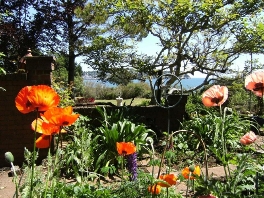What to do in the garden April 14: pot summer bulbs
Now is the time to tuck summer bulbs up in their pots safe from any late frosts


Now here is an ancient but all too rare vision of spring that really must be shared with you. It's at Hergest Croft in Herefordshire, where generations of the Banks family have made some of the finest gardens in the country and one of the greatest private arboreta in the world.
In the Kitchen Garden, two narrow, 120ft-long borders run parallel, forming an avenue that sweeps gently downhill from the glasshouses to open country. They're a form of orchard, in that their principal feature is two rows of venerable apple trees with low-branched crowns and picturesque twigs. They're known, however, as the Spring Borders, and rightly so.
Around now, they become awash with forget-me-nots punctuated by tulips, hyacinths and crown imperials. As the bulbs go over, late spring- and early summer-flowering perennials take their place, traditional favourites such as herbaceous peonies, bearded irises, leopard's bane and bleeding hearts. This pageant unfolds beneath a canopy of blossom: blushing and tight-budded in bulb-time, full-blown for the perennials, when it blows about them like confetti.
Begun towards the end of the 19th century and refurbished by each generation of the family ever since, the Spring Borders are possibly the oldest and certainly the best extant example of decorative planting under apple trees. Others sprang up in the next century, but the idea feels far older, perhaps medieval in origin. There's something of the monastery garden and the herbal about its combination of the useful and the ornamental, something of the book of hours about its framed and illuminated beauty. This style is also, so far as I can tell, British in origin. We should make more borders like them.
Elsewhere at Hergest Croft, spring visitors are transfixed by a small shrubby tree that sits in a glade. In its glory between now and July, this specimen exhibits what has to be the most brilliant new growth of any hardy woody plant. Shimmering scarlet turning to luminous crimson, it is an improbable outburst amid the evergreens that surround it. Several admirers tell me that they mistook it for an azalea. It is, in fact, a Japanese maple (Acer palmatum), a species more usually cherished for its autumn colour. Hergest Croft's owner, Lawrence Banks discovered it near Tokyo in 1980, at the nursery of Jiro Kobayashi, a famous maple breeder.
Since then, the requests for it have been legion, but the trick of grafting its peculiarly slender twigs was only mastered recently, and it's only just become available at Hergest Croft in limited numbers. Demand, I suspect, will soar. This maple is perfect for painting the shadows of shrubberies and woodland plantings. Petite and well behaved, it's also ideal for town gardens and large pots on terraces.
With the maple poised to go into the world, a question arises: what to call it? This prodigy was unnamed when Mr Banks acquired it. Although similar to two small Acer palmatum cultivars with bright-red spring foliage, Benimaiko and Shindeshojo, it's more dainty and dazzling than either. Japanese experts have pronounced the Hergest Croft tree distinctive.
Sign up for the Country Life Newsletter
Exquisite houses, the beauty of Nature, and how to get the most from your life, straight to your inbox.
‘One of them asked me if it had a bumpy bottom,' says Mr Banks. ‘She was trying to discover if the plant I bought had been grafted. If not, it must have been raised from seed, which would accord with the view that it's a novel variant. I'm pleased to say the maple's bottom isn't bumpy.' Aptly enough, Japan now becomes the source of this new tree's name. Back when Mr Banks was often there on banking business, he acquired the nickname Ginko-san, ginko being Japanese for bank. As a souvenir of those days, this cultivar has been named Acer palmatum Ginko-san.
Hergest Croft Gardens, Ridgebourne Road, Kington, Herefordshire HR5 3EG (01544 230160; www.hergest.co.uk). Open April 1-October 31, daily, 12 noon-5.30pm.
A Flower Fair on Bank Holiday Monday (May 3) runs from 10.30am to 5.30pm, in aid of St Michael's Hospice, with unusual plants for sale
* For more gardening stories like this every week, subscribe and save
Country Life is unlike any other magazine: the only glossy weekly on the newsstand and the only magazine that has been guest-edited by HRH The King not once, but twice. It is a celebration of modern rural life and all its diverse joys and pleasures — that was first published in Queen Victoria's Diamond Jubilee year. Our eclectic mixture of witty and informative content — from the most up-to-date property news and commentary and a coveted glimpse inside some of the UK's best houses and gardens, to gardening, the arts and interior design, written by experts in their field — still cannot be found in print or online, anywhere else.
-
 Six rural properties with space, charm and endless views, as seen in Country Life
Six rural properties with space, charm and endless views, as seen in Country LifeWe take a look at some of the best houses to come to the market via Country Life in the past week.
By Toby Keel
-
 Exploring the countryside is essential for our wellbeing, but Right to Roam is going backwards
Exploring the countryside is essential for our wellbeing, but Right to Roam is going backwardsCampaigners in England often point to Scotland as an example of how brilliantly Right to Roam works, but it's not all it's cracked up to be, says Patrick Galbraith.
By Patrick Galbraith